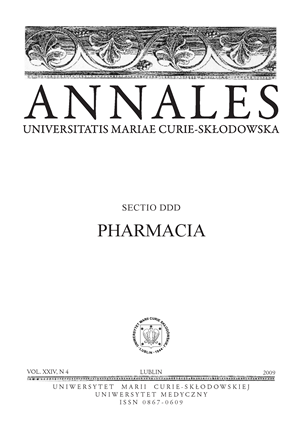Interaction of ketoprofen and paracetamol with melanin in vitro
Abstract
We have demonstrated that ketoprofen and paracetamol form stable complexes with melanin and the amount of drug bound to the polymer increases with the increase of the initial drug concentration and the incubation time. The analysis of drugs binding to melanin has shown that at least two classes of independent binding sites must be implicated in these complexes formation: strong binding sites (n1) with the association constant K1~ 4-6•105 M-1 and weak binding sites (n2) with K2~2•104 M-1. The ability of the analyzed drugs to form complexes with melanin in vitro may be one of the reasons for their phototoxic side-effects in vivo, as a result of their accumulation in melanin in the skin.
References
1. Alaluf S., Atkins D., Barrett K. et al.: Ethnic variation in melanin content and composition in photoexposed and photoprotected human skin. Pigment Cell Res., 15, 112, 2002.
2. Binns F., Chapman R. F., Robson N. C. et al.: Studies related to the chemistry of melanins. Part VIII. The pyrrolecarboxylic acids formed by oxidation or hydrolysis of melanins derived from 3,4-dihydroxyphenethylamine or (±)-3,4-dihydroxyphenylalanine. J. Chem. Soc. C, 1128, 1979.
3. Diaz R.L., Gardeazabal J., Manrique P. et al.: Greater allergenicity of topical ketoprofen in contact dermatitis confirmed by use. Contact Dermatitis, 54, 239, 2006.
4. Goossens A.: Photoallergic contact dermatitis. Photodermatol. Photoimmunol. Photomed., 20, 121, 2004.
5. Hearing V.J.: Biogenesis of pigment granules: a sensitive way to regulate melanocyte function. J. Dermatol. Sci., 37, 3, 2005.
6. Hennessy A., Oh C., Diffey B., Wakamatsu K. et al.: Eumelanin and pheomelanin concentrations in human epidermis before and after UVB irradiation. Pigment Cell Res., 18, 220, 2005.
7. Ibrahim H., Aubry A. F.: Development of a melanin-based high-performance liquid chromatography stationary phase and its use in the study of drug-melanin binding interactions. Anal. Biochem., 229, 272, 1995.
8. Ito S., Wakamatsu K.: Quantitative analysis of eumelanin and pheomelanin in humans, mice, and other animals: a comparative review. Pigment Cell Res., 16, 523, 2003.
9. Kalbitzer H.R., Stehlik D.: On the analysis of competitive binding of various ligands to cooperative and independent binding sites of macromolecules. Z. Naturforsch., 34c, 757, 1979.
10. Kongshoj B., Thorleifsson A., Wulf H.C.: Pheomelanin and eumelanin in human skin determined by high-performance liquid chromatography and its relation to in vivo reflectance measurements. Photodermatol. Photoimmunol. Photomed., 22, 141, 2006.
11. Larsson B. S.: Interaction between chemicals and melanin. Pigment Cell Res., 6, 127, 1993.
12. Matthieu L., Meuleman L., van Hecke E. et al.: Contact and photocontact allergy to ketoprofen. The Belgian experience. Contact Dermatitis, 50, 238, 2004.
13. Meredith P., Sarna T.: The physical and chemical properties of eumelanin. Pigment Cell Res., 19, 572, 2006.
14. Newson R. B., Shaheen S. O., Chi n n S., Bu r ney P. G.: Paracetamol sales and atopic disease in children and adults: an ecological analysis. Eur. Respir. J., 16, 817, 2000.
15. Yamaguchi Y., Takahashi K., Zmudzka B. Z. et al.: Human skin responses to UV radiation: pigment in the upper epidermis protects against DNA damage in the lower epidermis and facilitates apoptosis. FASEB J., 20, E630, 2006.
Downloads
Published
Issue
Section
License
Copyright (c) 2025 Ewa Buszman, Dorota Wrześniok, Janina Trzcionka, Ewa Miernik-Biela, Marta Stróż (Autor)

This work is licensed under a Creative Commons Attribution-NonCommercial-NoDerivatives 3.0 Unported License.


